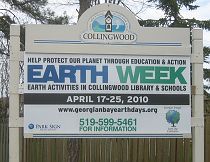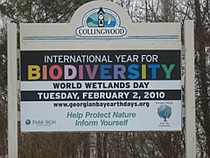Summer Readings for 2011 Take Us to New Heights for Inspiration and Action
“There is no such thing as a green pepper… All peppers start out some shade of green (either dark, light or yellowish) and gradually turn red, yellow, orange or even purple as they mature and sweeten. A green pepper, like a green tomato, is simply unripe.” Patrick Lima and John Scanlan’s “The Organic Home Gardener”
“Nature loves man, beetles, and birds with the same love.” John Muir
“We have done deeds of charity, made peace of enmity, fair love of hate, between these swelling wrong-incensed peers.” Shakespeare’s Richard the Third
Patrick Lima and John Scanlan’s just released second printing of “The Organic Home Garden” is joyously required reading for anyone who loves to garden. These Bruce Peninsula heroes of soil, seeds and thirty plus years of creative sweat have toiled to create the perfect book for both beginners and callused-handed inveterate gardeners. “The Organic Home Garden” is far more than a ’how to’ book. Yes, we learn about the proper care of raising many vegetables but also find inspiration in the photos and finely crafted words of these two men. The authors’ passion can not but strike a chord of reverence for the Earth. Patrick Lima’s quiet prose conjures up all that is beautiful in the garden. “…it is a pleasure to potter in the tomato bed, pushing in stakes, plucking suckers, tying the hairy stems with strips of old bed sheets, watching the fruit swell from week to week, then blush pink and finally redden.” And the many subject headings draw in the reader: “Of Suckers and Stakes”, Bugs, Cracks and Cat-facing”, “In the Trenches”, “Of Mulch, Maggots and Mold” and “Midsummer Miscellany” are just a few intriguing titles that make us want to read more. From the care of herbs to the potato and great cooking recipes, there is cause to celebrate the new edition of this Canadian classic. Without a doubt, a summer visit to ‘Larkwhistle’ will inspire you to be a better gardener and cherish these organic gardeners’ wisdom. Don’t wait till you are reading their book in bed on a cold winter’s night dreaming of new sowings of shallots and spinach; visit ‘Larkwhistle now and buy it there. Call 519 795-7763 for directions and hours to visit.
When is the last time you read Shakespeare’s “Richard the Third”? Although Stratford is a two hour journey, every year I find myself dusting off a play of Shakespeare’s and recall the prose and poetry of Elizabethan England’s fantastic vistas of the sublime and the treacherous: “Richard the Third” offers us both. Although we may wish to see Richard’s demise, what brought him to such murderous actions reverberates in today’s political theatres. Civil wars, greed, loyalty and love for ones kin can’t help making this play a ‘hit’ with audiences since 1593. I have never seen a play at Stratford with a stronger cast. It’s not only Seana McKenna, who brilliantly shines as the female- playing Richard but every actor is powerfully played. The stage craft is superb. Miles Potter’s direction of the play is creative and sensitive.
Donald Worster’s “A Passion for Nature: the Life of John Muir” should be on every nature lovers book shelf. Many of us know that the Sierra Club’s first president was John Muir and indeed a resident of Meaford for a year and a half, but few of us know how John’s religious upbringing was transformed into a powerful voice for Nature. Throughout this 466 page biography John Muir, the man, is portrayed first and foremost as a quiet advocate of people’s right to experience nature but never to overrule or abuse her. Muir’s adventures in the Sierra Mountains or in Alaska can be found here and in his short essays and articles. .Although he was a very reluctant spokesperson for conservation, his powerful and unadorned authentic passion for wilderness won over all segments of society, leading to the establishment of the world’s first national parks. Just as importantly, we learn about those people who shared his conservation goals, including the wonderful women in his life. Worster sums up John’s contributions this way: “The ultimate destination of the conservation …movement that Muir helped found is to transform the United States and other nations into “green” societies where pollution and waste of natural resources will have diminished significantly, where nature will become more than a ruthlessly exploited or even prudently managed “economic resource”. Nature will be granted a higher emotional, spiritual, and aesthetic value- a value in itself. No one in the nineteenth century America was more important than Muir in persuading people to move toward such a vision.”

